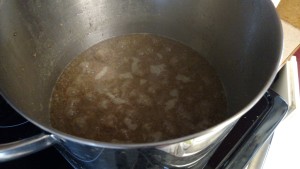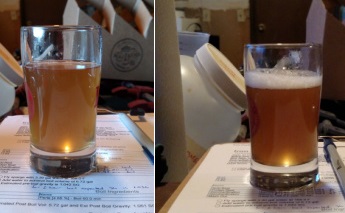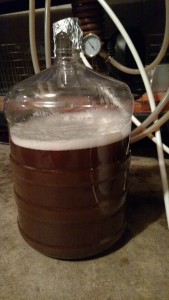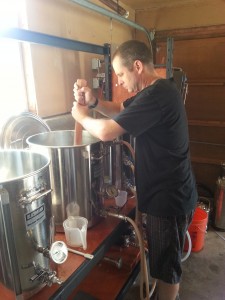It is not normal when I don’t look forward to a brew day. So I have to thank my homebrew club’s Iron Brewer competition for ruining this brew day for me. Iron Brewer works similarly to its namesake. Three brewers are given two ingredients or rules for their beer. Everything else is up to the brewer. For this brew, we were given no ingredients. Only restrictions. We could only use fermentables of 3L or lower and the finished beer had to be 17SRM or higher.
So where does that leave us? Clearly any highly kilned or roasted grain is out. Fruit is a fermentable so anything that would provide color can’t be used. Highly toasted oak isn’t technically a fermentable, but the challenge only gives us two months so there is a risk that the wood character wouldn’t meld properly. I’m probably leaving out some options, but I didn’t have much time to get this beer put together.
So what I landed on after a week of debate then changing my mind last second at the homebrew shop is a take on a dunkelweizen. I can’t use the traditional Munich malt for the style so I need to make up for that somehow. My method for getting some additional malt character and color is decoction and a long boil. Now you can see why I was not looking forward to this brew day.
The Decoction
A decoction mash is a more intensive process than a standard single infusion mash. In essence, it is a step mash that has you remove a portion of the bash, boil it and return it to the mash to raise the temperature. Doing a decoction is supposed to give you some color and flavor impact, but a quick internet search will lead you to the debate over whether the flavor impact is meaningful. Decoction can be done as a single, double or triple, which essentially dictates how many steps you will do.
I decided to do a triple decoction. Whatever color change I can wring out of this process I need to get. This is the part of the day that I was not looking forward to at all. The portion of the mash you pull for the decoction is intended to be thick. You want to leave as much fluid as possible in the mash tun. Boiling a thick portion of the mash leaves you at risk for scorching the grain and being left with a burnt flavor in the beer. So you need to keep stirring the decoction to keep that from happening. That can lead to a tiring brew day!
Adding to my tiring day is the fact that my brew system is in the garage and my brew kettle can’t boil anything less than 4.5 gallons. So that means I have to take my mash up and down the stairs to the kitchen for each decoction step. A rather unfortunate setup, but it is part of the limitation of my electric system.
 By my third decoction (picture above), I was getting some brown color. I was pulling at most 1.75 gallons from my 4.5 gallon mash, so the overall effect was less than the picture above because it was diluted each time I added it back to the mash.
By my third decoction (picture above), I was getting some brown color. I was pulling at most 1.75 gallons from my 4.5 gallon mash, so the overall effect was less than the picture above because it was diluted each time I added it back to the mash.
The Boil
I planned for a two hour boil. Since I have to keep at least 4.5 gallons in the kettle during the boil I couldn’t just boil until I got the color I wanted. Adding water would thin out the beer and actually lighten the beer.
 The image on the left is the preboil wort. The right is after one hour. The wort is already darkening substantially. If I had this to do over again, I would tone down how hard the wort was boiling. After doing the brew day, I read that the maillard reaction that darkens the beer really only needs to be above 190 degrees F. So I could have kept it to more of a simmer and kept it going longer to slow my evaporation rate. Going into the day I assumed I needed to boil hard to get the most color.
The image on the left is the preboil wort. The right is after one hour. The wort is already darkening substantially. If I had this to do over again, I would tone down how hard the wort was boiling. After doing the brew day, I read that the maillard reaction that darkens the beer really only needs to be above 190 degrees F. So I could have kept it to more of a simmer and kept it going longer to slow my evaporation rate. Going into the day I assumed I needed to boil hard to get the most color.
In the end this brew day took my almost 12 hours. That is more than double my normal brew day. I won’t be doing this sort of brew again anytime soon, but I can at least say I’ve done a decoction. They are tough, but the stirring wasn’t quite as bad as I was expecting.

I ended up getting quite a bit of color in this beer. I pitched dry hefeweizen yeast that has it looking a milky, light brown. Definitely does not look like a beer you’d want to drink at the moment, but we’ll see how it looks at the end of fermentation. I figured a hefeweizen yeast could help with the perception of dark color by making the beer hazy. The judging for this competition won’t be until mid March so I won’t have an update on the results for awhile.
